
Decarbonization
The JX Advanced Metals Group views climate change as an urgent issue that must be resolved on a global scale, and in order to contribute to the resolution of this issue, we have set the ultimate goal of achieving net zero CO2 emissions and are further accelerating our efforts to achieve this goal.
Decarbonization Vision
The Group's businesses focus on resource recycling, particularly through recycling materials, aiming to reduce CO2 emissions, including Scope 3 emissions, and the carbon footprint of our products (CFP). We are committed to meeting customer needs while advancing both resource circulation and decarbonization. In June 2024, we developed a vision for decarbonization consisting of five initiatives.
Decarbonization Vision
We will promote decarbonization activities that simultaneously fulfill customer needs, provide integrated solutions to social challenges, and enhance the appeal of our products through the following five initiatives.
- 1.Reduction of CO2 emissions centered on resource recycling
- 2.Reduction of CO2 emissions throughout the entire supply chain through external collaboration
- 3.Simultaneous reduction of Scope 1, 2, and 3 emissions aimed at reducing the CFP of our products
- 4.Reduction of CO2 emissions by utilizing our own materials technology
- 5.Contribution to nature-positive through CO2 reduction and evaluation
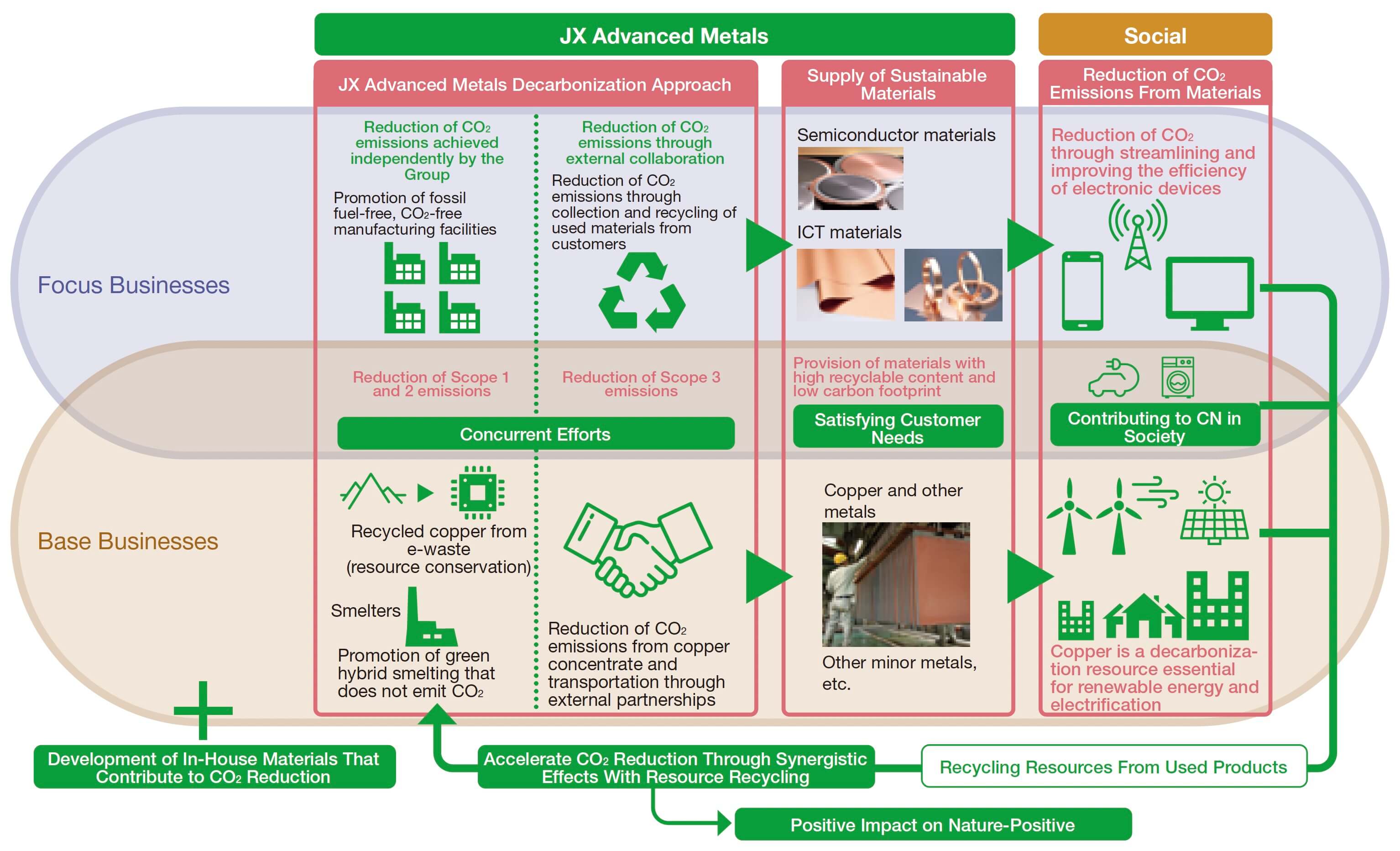
Disclosure Based on the TCFD Recommendations

In accordance with the TCFD's recommendations, the Group will strive to proactively disclose information based on the disclosure framework of Governance, Risk Management, Metrics and Targets, and Strategy. We will also take concrete measures to address climate change.
Governance
The ESG Committee, an advisory body to the president, is responsible for formulating basic policies regarding the Group's response to climate change, setting priority targets, and monitoring these targets. The ESG Committee is chaired by the pres-ident of the Company, with members from the Executive Council and with participation by outside directors as observers. This committee meets twice a year in principle. Matters deliberated and decided are discussed at and reported to the Executive Council and the Board of Directors as appropriate, depending on the content.
Risk Management
At the Group, the ESG Promotion Department works with each department to assess and identify risks and opportunities related to climate change, including scenario analysis, in accordance with the framework of the TCFD recommendations. The department recently collected and analyzed information for scenario analysis of a wide range of risk factors associated with climate change impacts, including regulations and business impacts. We also began to identify our own risks and opportunities related to climate change response, as well as medium- to long-term business strategy measures. The results of the analysis and the status of measure implementation are shared with management through the ESG Committee and other channels. Based on this, each department takes action in these areas in cooperation with the ESG Promotion Department.
Systems for Climate Change Action
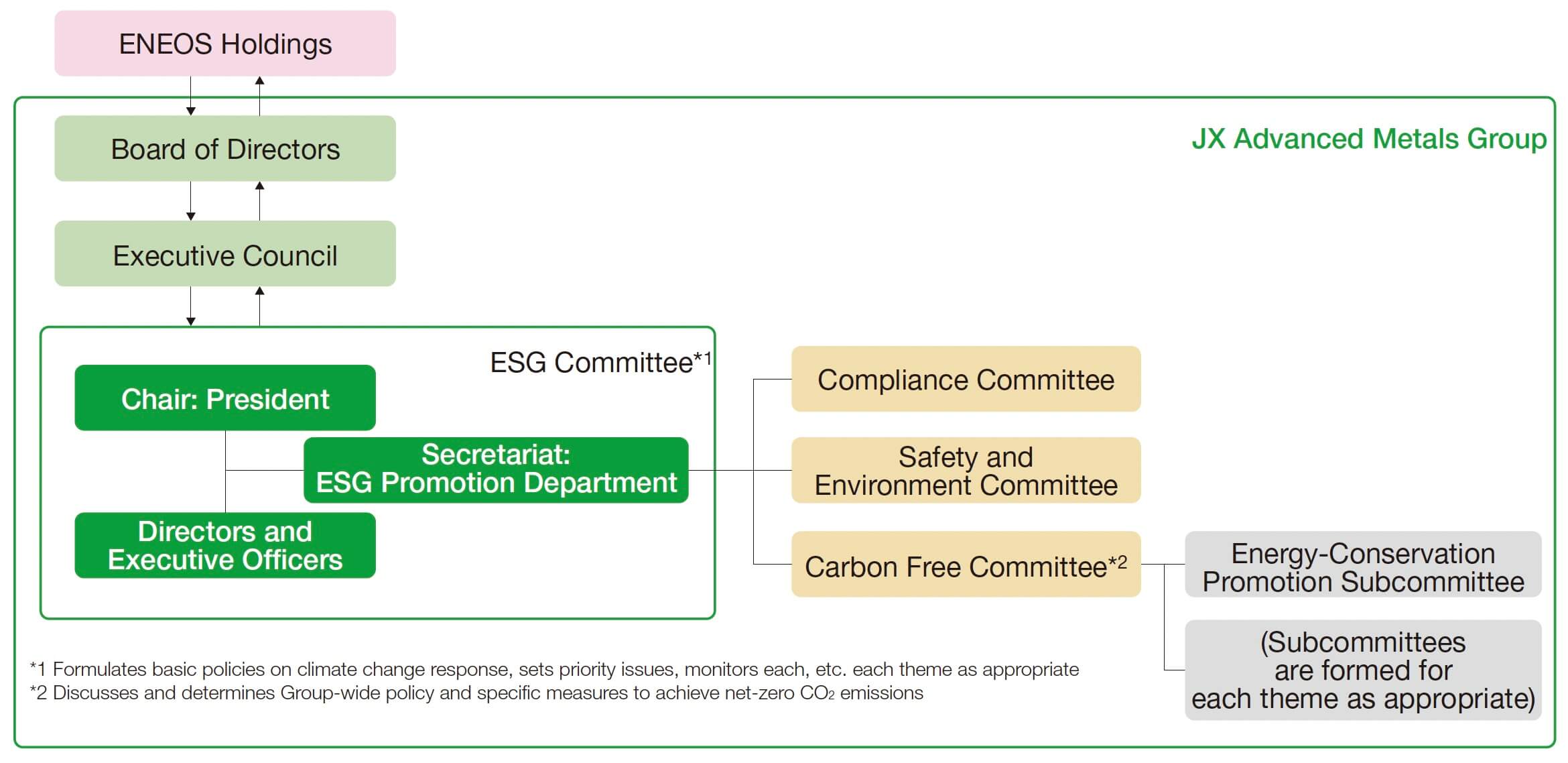
Metrics and Targets
The Group has established our in-house CO2 emissions (Scope 1 and 2) as an indicator of climate change and aims to achieve net-zero emissions by fiscal 2050. We have set an interim target of a 50% reduction by fiscal 2030 versus Scope 1 and 2 total in-house emissions in fiscal 2018, based on backcasting from our fiscal 2050 goal.

Strategy
1. Recognition of Climate Change-Related Risks and Opportunities
[Analysis of climate change-related risks and opportunities]
In identifying the risks and opportunities that climate change poses to our Group and businesses, and in considering strategies to address risks and capture opportunities, we referenced the International Energy Agency's (IEA) World Energy Outlook (WEO). Furthermore, we analyzed global warming scenarios from the United Nations Intergovernmental Panel on Climate Change (IPCC).
[Identified risks and opportunities]
Assuming a transition to a decarbonized society in the wake of climate change, the Group's businesses will play a major role in shifting the power generation mix to renewable energy sources, transforming power use in ways such as electrification, and achieving social implementation of the circular economy, and opportunities for increased product demand and evolution of our offerings are expected.
On the other hand, there are risks such as increased costs associated with the Group's own efforts to become carbon neutral on a global basis and lost opportunities due to delays in this process. In addition, there are potentially increased physical risks of extreme weather events damaging production facilities and logistics networks at operating sites in Japan and overseas, resulting in shutdowns.
Identified Risks and Opportunities
| Category | Impact | Risk/Opportunity | Measures |
|---|---|---|---|
|
Transition Risks |
Policies and Regulations | Increased costs to achieve net-zero CO2 emissions |
|
| Introduction and strengthening of carbon taxes, etc. in Japan and abroad |
|
||
| Reputation | Loss of opportunity due to delayed action toward decarbonization and environmental impact reduction |
|
|
|
Physical Risks |
Acute | Damage to facilities and shutdowns due to extreme weather events |
|
|
Opportunities |
Products | Increased demand for nonferrous metals needed for a decarbonized society (Base Businesses) |
|
| Increased demand for high-end electronic materials (Focus Businesses) |
|
||
| Circular Economy | Realizing circular economy |
|
|
| Increased demand for and mandated recycling of automotive LiBs |
|
2. Scenario Analysis
Assuming a transition to a decarbonized society in the wake of climate change, the Group’s businesses will play a major role in shifting the power generation mix to renewable energy sources, transforming power use in ways such as electrification, and achieving social implementation of the circular economy. Opportunities for increased product demand and the evolution of our offerings are also expected.
On the other hand, there are risks such as increased costs associated with the Group's own efforts to become carbon neutral on a global basis and lost opportunities due to delays in this process. In addition, there are potentially increased physical risks of extreme weather events damaging production facilities and logistics networks at operating sites in Japan and overseas, resulting in shutdowns.
1. Transition Risks
(1) Increased costs to achieve net-zero CO2 emissions
Electricity accounts for approximately 60% of our Group's total CO2 emissions (Scope 1 and 2), and we are switching to CO2-free electricity at our major operating sites in Japan and overseas. We are also considering measures to generate renewable energy on our own and to address energy sources other than electricity used in our manufacturing processes.
Although additional costs are incurred in the necessary initiatives to achieve this, in the form of capital investment, R&D expenses, and the price difference (premium) between CO2-free electricity and traditional electricity, we will steadily move toward decarbonization through the use of transition financing, a first in the nonferrous metals industry, and by reducing costs through energy-conservation activities.
(2) Introduction and strengthening of carbon taxes, etc. in Japan and abroad
Carbon taxes are being considered for introduction in Japan and abroad. If these or other systems are introduced, there is a risk of cost increases based on CO2 emissions. If a carbon tax is introduced, the annual cost increase is expected to be approximately 7 billion yen.
The Group has established a roadmap toward carbon neutrality and is steadily implementing various initiatives to reduce CO2 emissions, so the cost burden is expected to be relatively insignificant.
- *Fiscal 2018 Scope 1 and 2 emissions x 50% (2030 target): CO2e x USD50/t- CO2e x assumed exchange rate
(3) Loss of opportunity due to delayed action toward decarbonization and environmental impact reduction
If CO2 emission reductions do not proceed according to the roadmap or if other environmental impacts increase, there is a risk that the Group may suffer harm to our social credibility. In addition, delays in responding to climate change-related requests from customers could result in reduced sales opportunities.
The Group pursues steady decarbonization initiatives and responds to individual customer requests. We also develop technologies and make capital investments to reduce our carbon footprint (CFP) and increase the percentage of recycled raw materials in accordance with the Sustainable Copper Vision. We are also building partnerships with external parties to achieve and disseminate the Sustainable Copper Vision.
2. Physical Risks
(1) Damage to facilities and shutdowns due to extreme weather events
Extreme weather conditions, including intensifying typhoons, increase the risk of domestic and international production sites, suppliers, and logistics networks being affected, leading to potential disruptions in normal operations. The Group has conducted analyses using hazard maps and other data at our major operating sites in Japan and confirmed that the risk of damage from extreme weather events is low. In addition, we have established business continuity plans (BCPs), and conduct periodic training and reviews to promote the establishment of Business Continuity Management (BCM). We believe that these measures will keep the impact on our business to relatively minor levels even if the risk of damage to facilities or shutdowns due to extreme weather events materializes.
3. Opportunities
(1) Increased demand for copper needed for a decarbonized society (Base Businesses)
Needs for renewable energy and electrification of mobility are expected to grow significantly toward the realization of a decarbonized society, and copper will be increasingly used in these areas. This growing demand is expected to provide opportunities for further sales and revenue growth for the Group. The Group is working to strengthen our business through portfolio reviews, and is taking various measures to increase the input recycling raw materials ratio and reduce our CFP in Green Hybrid Smelting, which utilizes both copper concentrate and recycled raw materials, in order to establish a stable supply system.
The supply of electrolytic copper and electronic materials with a high ratio of recycled raw materials and low CFP realized through these efforts will contribute not only to the realization of a resource-recycling society but also to the strengthening of our business competitiveness.
(2) Increased demand for high-end electronic materials (Focus Businesses)
In addressing climate change, it is essential to significantly improve energy use efficiency using technologies such as IoT, AI, and 5G/6G. Many high-end electronic materials are used in these fields, and demand for these materials is expected to continue to grow. The Group has a product lineup with a strong global market share in the electronic materials field, including sputtering targets and treated rolled copper foil for FPC.
Currently, we are constructing several new plants and increasing capacity to meet strong demand. In addition, we are working to construct a new plant in Hitachinaka City, Ibaraki Prefecture, and in and Mesa City, Arizona, the U.S., in anticipation of further growth in demand. In addition to these capital investments, from a longer-term perspective, the Advanced Technology & Strategy Department is taking the lead in open innovation through industry-academia collaboration and investment in startups.
(3) Realizing circular economy
Though demand for copper will continue to grow over the long term as the world moves toward a decarbonized society, the supply of copper ore and recycled raw materials from existing mines is limited.
The Sustainable Copper Vision we have established aims to build a stable supply system to support growing copper demand through Green Hybrid Smelting that utilizes both copper ore and recycled raw materials. As one of our measures to evolve and gain wider use of sustainable coppers, we are working on technological development to increase the recycled raw materials ratio (input ratio of raw materials or content ratio in products) to 50% or more by 2040. To this end, it is essential to enhance our system for collecting and processing recycled raw materials. Here, we will not only strengthen the supply chain through capital investment and M&A, but also form Green Enabling Partnerships with companies, local governments, universities, and research institutions who work together to promote sustainable copper. Through these partnerships, we engage in product and scrap collection, raw materials reuse, and joint technology development.
By utilizing not only our own resources but also the global network and knowledge of our partners, we will strengthen the collection of recycled raw materials and collaborate with recyclers in Japan and abroad to reform and digitize recycling processes.
(4) Increased demand for and mandated recycling of automotive LiBs
Electric vehicles (EVs) are expected to become widespread as part of a decarbonized society. This will increase demand for lithium, cobalt, and nickel used in lithium-ion batteries (LiBs) in EVs. There are also concerns about geopolitical risks and rising resource nationalism surrounding these resources. Future large-scale disposal of LiBs is also expected, requiring their efficient recycling.
The Group is working to develop technologies, conduct demonstration trials, and establish a resource recycling system throughout the supply chain with the aim of realizing closed-loop recycling to extract the aforementioned metals from automotive LiBs reaching end of life (EoL) in as automotive battery materials.
Current Status of CO2 Emissions
Reduction of CO2 Emissions (Scope 1 and 2)
JX Advanced Metals Group Scope 1 and 2 Emissions
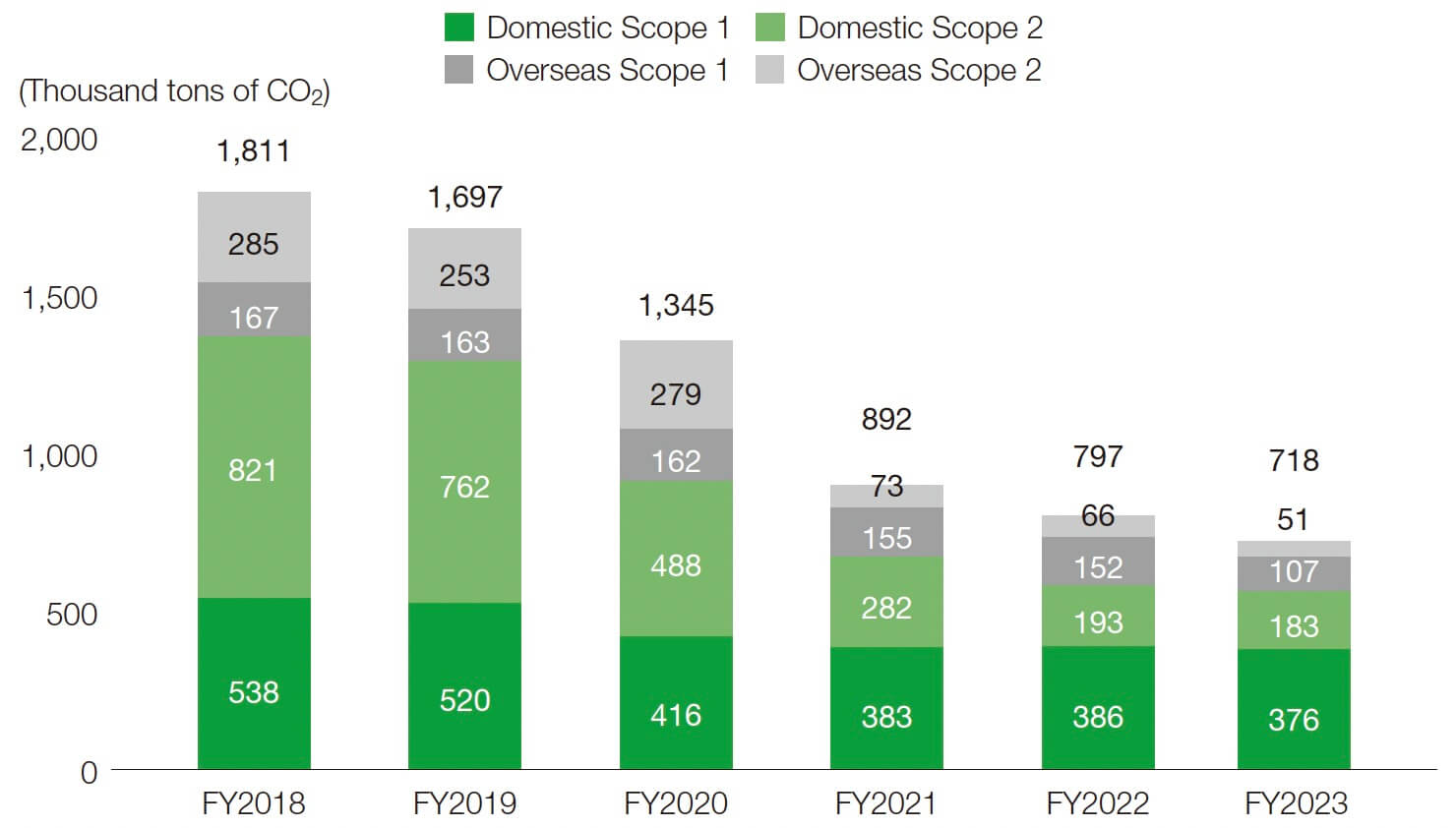
Toward our goals of reducing our total in-house CO2 emissions by fiscal 2030 and fiscal 2050, we are working on the introduction of CO2-free electricity, generation of renewable energy, promotion of zero energy loss activities, and fuel switching and technology development toward decarbonization. Our in-house CO2 emissions in fiscal 2023 (total of Scope 1 and 2) were 718 thousand t-CO2.
Calculation of CO2 Emissions (Scope 3)
Scope 1, 2, and 3 Emissions (FY2023 results)
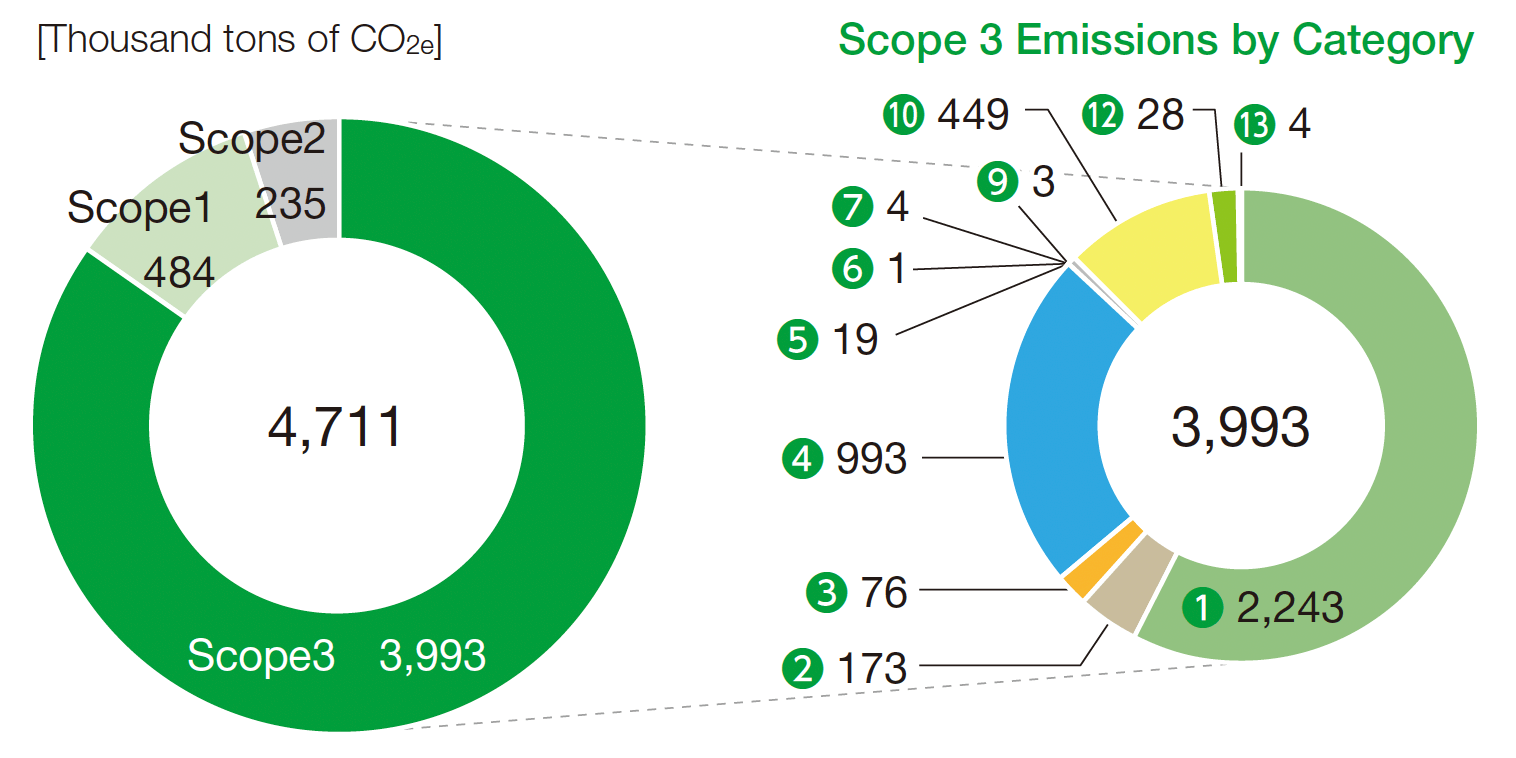
- * For details on the calculation criteria for Scope 3, please refer to this page.
In addition to existing data for Scope 1 and 2 CO2 emissions, in fiscal 2021, the Group began calculating indirect Scope 3 emissions in order to determine the overall CO2 emissions generated by our operations and products. We are currently studying ways to improve calculation methods and accuracy for each category, as well as to establish and implement the emission reduction roadmap.
Scope 3 Categories
❶Purchased goods and services ❷Capital goods ❸Fuel-and energy-related activities not included in Scope 1 or 2 ❹Upstream transportation and distribution ❺Waste generated in operations ❻Business travel ❼Employee commuting ❽Upstream leased assets ❾Downstream transportation and distribution ❿Processing of sold products ⓫Use of sold products ⓬End-of-life treatment of sold products ⓭Down-stream leased assets ⓮Franchises ⓯Investments
Introduced EV Buses for Commuting to Isohara Works
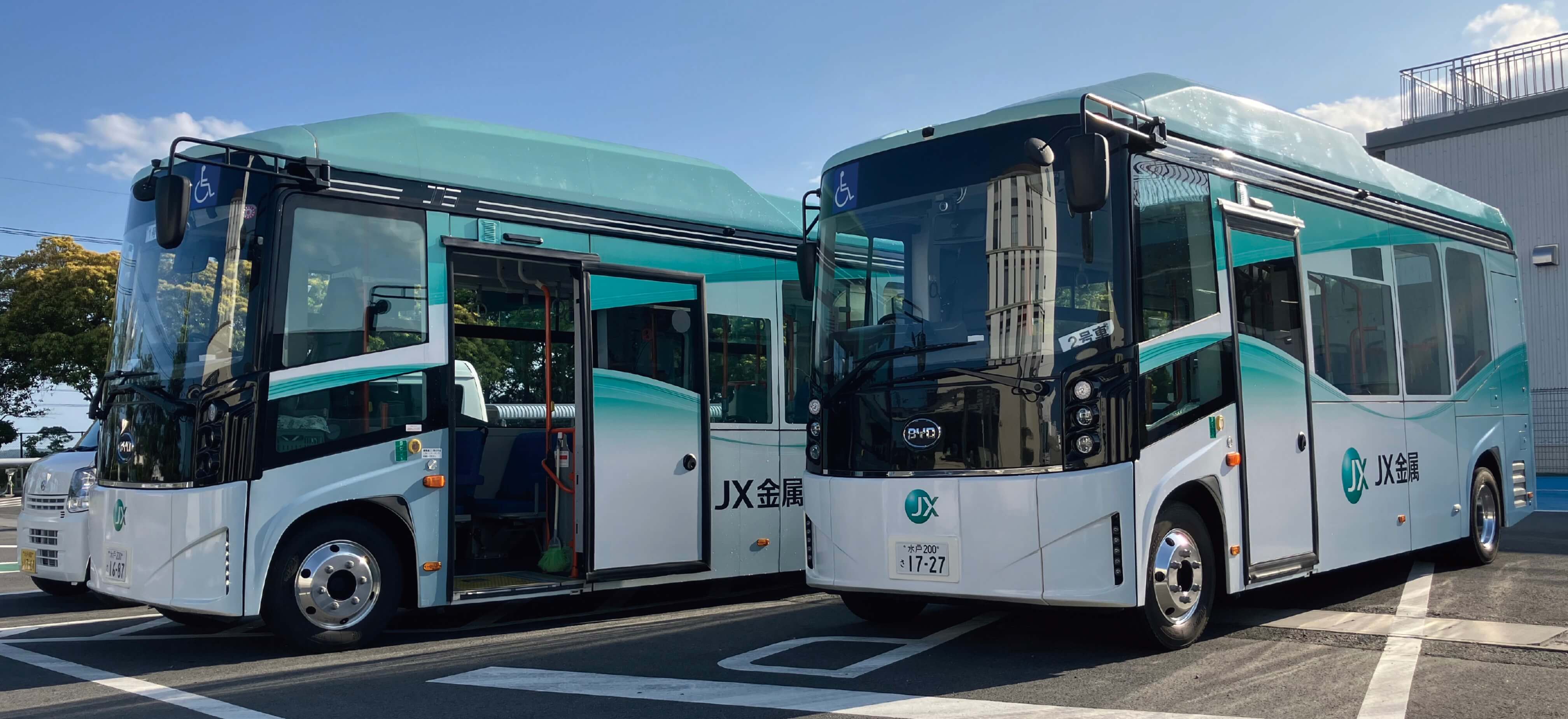
In October 2023, we introduced a new EV bus at the Isohara Works (Kitaibaraki City, Ibaraki Prefecture) as part of our efforts to reduce Scope 3 emissions.
The Isohara Works is located in the northern part of Ibaraki Prefecture, an area where commuting by car is the norm. We have been encouraging employees who drive their own cars to work to use public transportation to reduce CO2 emissions and ease traffic congestion on surrounding roads. Starting in April 2023, we implemented a policy to provide special fare allowances for commuting on the JR Joban Line. We are also working to reduce CO2 emissions while commuting by introducing an EV bus as a means of transportation between the Isohara Works and JR Isohara Station, the nearest station to the Isohara Works. In response to increased demand during work commutes, an additional EV bus of the same model was added to the fleet in April 2024, so that two buses are currently in operation.
These efforts have led to a reduction in CO2 emissions that fall under Scope 3, Category 7. In addition to being used for commuting, the buses are also used to take visitors to and from the plant, and in the future, we plan to use the buses for a variety of other purposes inside and outside the plant, including at local events.
Examples of Initiatives Toward Achieving Net Zero
Initiative(1)
Activities of the Carbon Free Committee■ Initiatives at Each Site to Realize the Decarbonization Vision
| Operating sites | Theme [Progress] |
|---|---|
| Isohara Works | Electrification of steam generation [Consideration of equipment specifications and installation space requirements] |
| Kurami Works | Hydrogen and ammonia alternatives to city gas [Consideration of collaboration with external organizations and companies] |
| Saganoseki Smelter & Refinery, JX Metals Smelting Co., Ltd. Hitachi Works | CO2 capture and utilization (CCUS) [Consideration of collaborators for CO2 concentration measurement and capture, equipment specifications, and installation space requirements] |
| Kasuga Mines Co., Ltd. | Decarbonization of heavy equipment [Research on electric heavy equipment and testing of biofuels as an alternative to diesel] |
The Carbon Free Committee was established in fiscal 2022 as an organization to discuss and decide on company-wide policies and specific measures to achieve net zero CO2 emissions. The committee is led by the ESG Promotion Department and includes executives from each business division and production site, the Technology Group, and management from each Group company. Since its establishment, the committee has been considering decarbonization and resource recycling measures that contribute to enhancing our business competitiveness and added value from a comprehensive and strategic perspective toward achieving CO2 net zero. We are accelerating our efforts with a focus on the early realization of Carbon-Neutral Plants (achieving net zero for Scope 1 and Scope 2 emissions at production sites). Specifically, we are considering electrification of steam boilers, utilization of hydrogen and ammonia as alternatives to city gas, early introduction of biofuels, and introduction of CO2 capture and utilization facilities.
In addition to these measures, the Carbon Free Committee is also working to reduce Scope 3 CO2 emissions to realize the JX Advanced Metals Group's Decarbonization Vision.
Initiative(2)
Initiatives for Decarbonized Electricity■ Renewable Energy Facilities and Total Electricity Generation (Fiscal 2023)
(Thousands of kWh)
| Site | Method | Generated |
|---|---|---|
| Kakinosawa Power Plant, JX Advanced Metals Corporation, | Hydroelectric | 23,336 |
| JX Advanced Metals Corporation, Kurami Works (Off-Site) | Solar | 6,142 |
| Kurami Works | Solar | 25 |
| Isohara Works | Solar | 280 |
| Wakamatsu Plant, Toho Titanium Co., Ltd. | Solar | 367 |
| Nikko Metals Taiwan Co., Ltd. | Solar | 218 |
| Nippon Mining & Metals (Suzhou) Co., Ltd. | Solar | 66 |
| JX Metals Korea Co., Ltd. | Solar | 146 |
| Japan Copper Casting Co., Ltd. | Solar | 6 |
Since approximately 60% of the Group's in-house CO2 emissions (Scope 1 and 2) come from electricity, we began introducing CO2-free electricity*1 in fiscal 2020. In fiscal 2023, the switch to CO2-free electricity was completed at most operating sites in Japan and overseas. We are also engaged in generating our own renewable energy.
To date, we have introduced hydroelectric, and solar power generation facilities at our operating sites in Japan and overseas. In April 2023, we implemented solar power generation using an off-site PPA model*2 for Kurami Works. This is the first time for the Group to adopt an off-site model outside a plant site. We expect power generation on the order of 9,000 kW (solar panel basis), making it one of the largest single-facility, off-site PPA model solar power generation systems in Japan.
In April 2024, we launched the largest on-site PPA solar power generation system within the Group at JX Metals Tomakomai Chemical Co., Ltd. The company is in the recycling business and contributes to resource recycling by using renewable energy created through the effective utilization of idle land at its business sites.
- *1CO2-free electricity: Electricity derived from virtually non-fossil-fuel power sources, etc., that does not result in CO2 emissions, with an adjusted CO2 emission factor of 0.00 t-CO2/kWh. This may include nuclear power as well as renewable energy such as hydro, wind, solar, etc.
- *2PPA: Power Purchase Agreement. A system in which a company or other facility owner leases its premise, roof, or other space, a power company installs a solar power generation system, and the facility owner uses the power generated and pays a fee
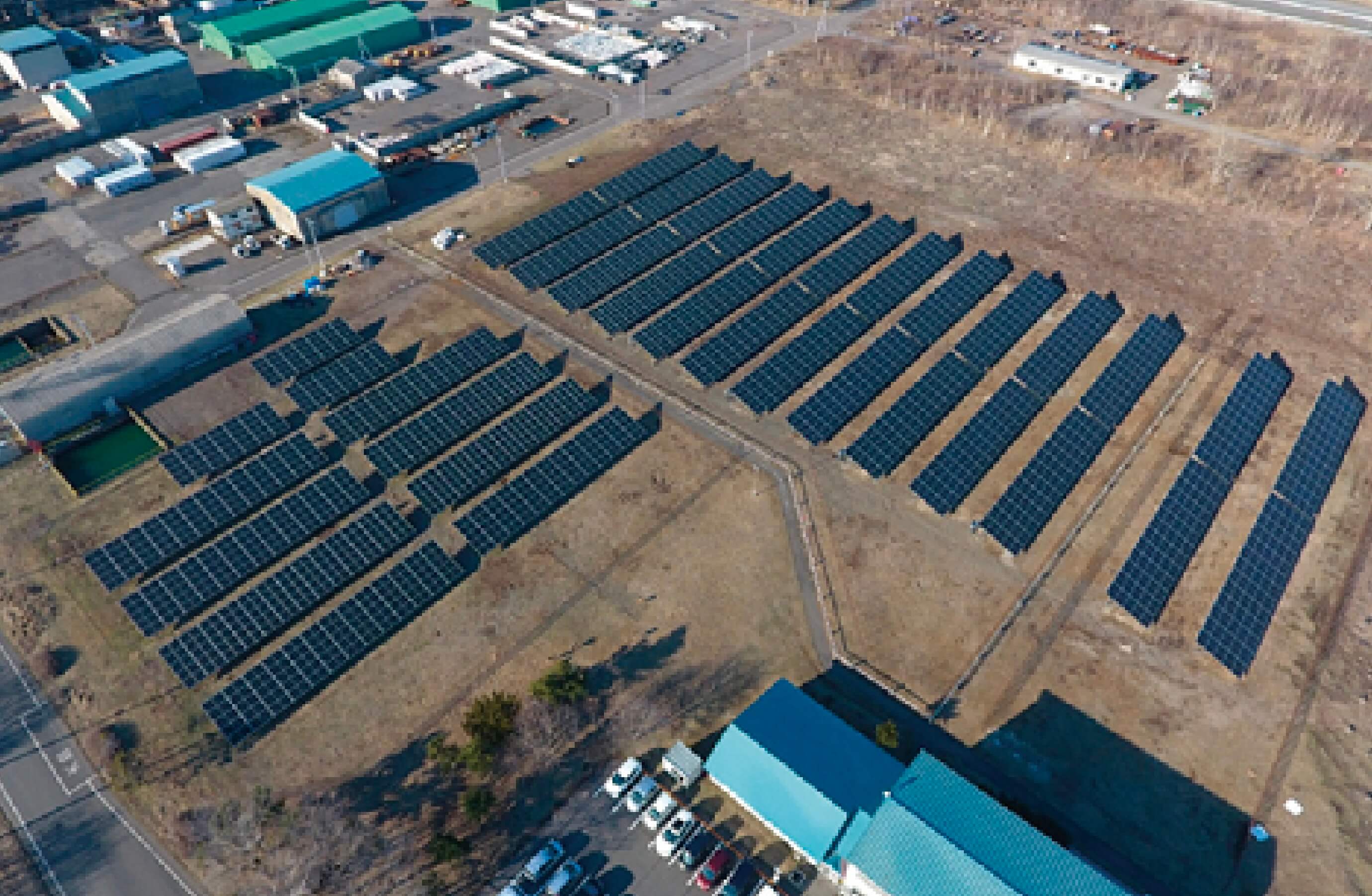
Initiatives(3)
Promotion of Zero Energy Loss ActivitiesAs a Group that operates electricity-intensive businesses, we have been promoting energy conservation activities at every stage of our business activities for some time. However, we believe it is now necessary to promote zero energy loss activities from new angles in order to achieve net-zero CO2 emissions. For example, the Energy-Conservation Promotion Sub-committee is leading initiatives to achieve zero energy loss, such as updating facilities with a focus on CO2 reduction that goes beyond cost reduction, and fundamentally reviewing facility operation methods.
Initiative(4)
Fuel Switching and Technology Development Toward Decarbonization- *1In this demonstration test, we used biodiesel fuel that has received the International Sustainability & Carbon Certification (ISCC), specifically Fatty Acid Methyl Ester (FAME), blended at approximately 24% with low-sulfur heavy fuel oil (VLSFO)
- *2A byproduct of the copper smelting process, it has a low CO2 load and is recycled as a raw material for cement and sandblasting materials
- *3Emissions generated throughout the fuel consumption cycle, meaning the process of fuel production, transportation, and use on board ships
- *4In this demonstration test, approximately 20% hydrogenated vegetable oil (HVO) was mixed with diesel oil
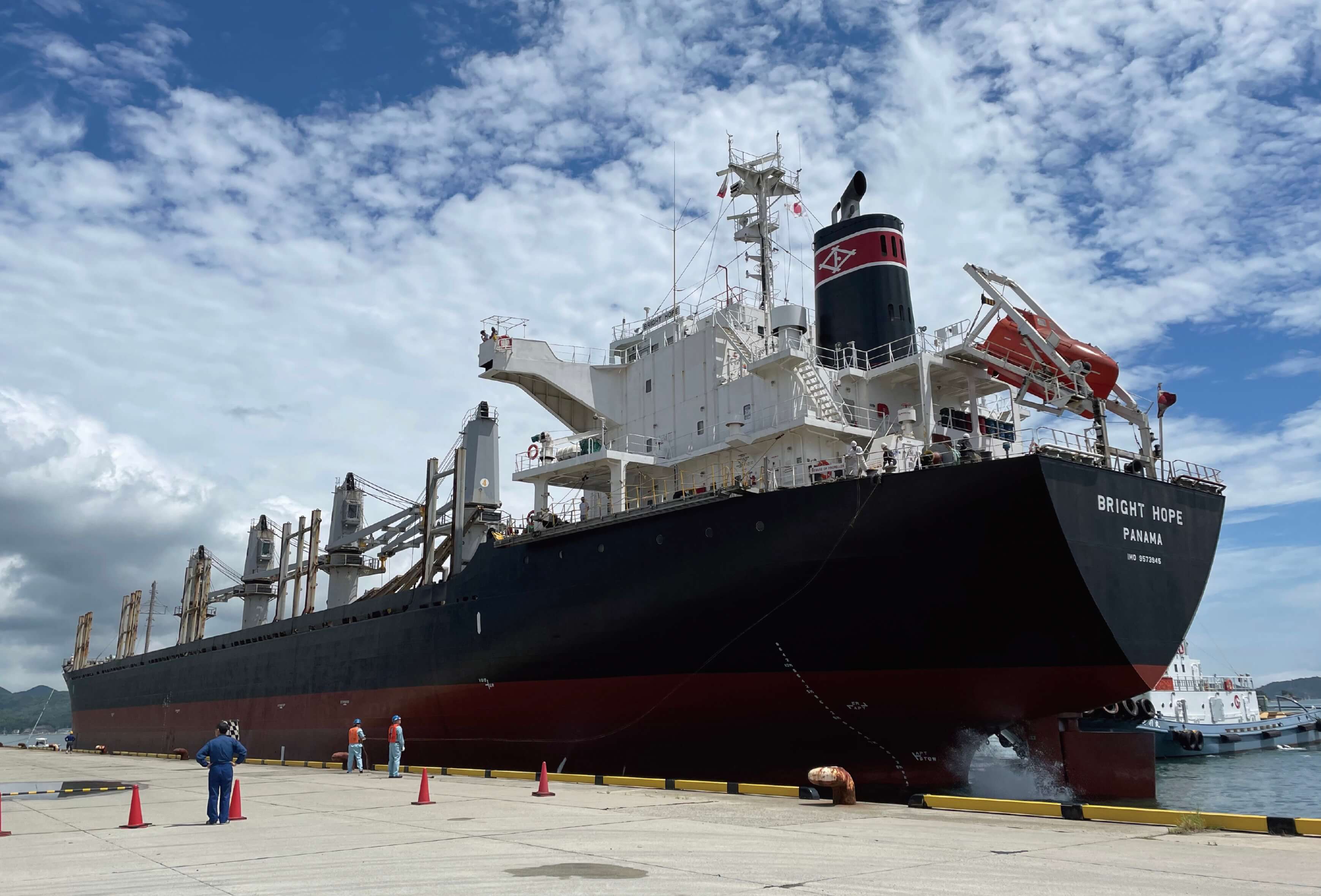
In addition to electricity, our business processes use heavy oil, coke as a reducing agent, and other energy sources, and we are working to reduce CO2 emissions from these sources. One candidate to achieve this is fuel switching. Industry is developing technologies for new fuels such as hydrogen and ammonia, and we are also considering their utilization within our Company.
In 2023, we conducted a demonstration test for the marine transportation of copper slag*2 using biodiesel fuel*1 —marking the first such initiative in the domestic non-ferrous metals industry— in collaboration with our group companies, Pan Pacific Copper Co., Ltd. and Iino Kaiun Kaisha, Ltd. The voyage was successfully completed as scheduled on September 10. On this voyage, copper slag handled by Pan Pacific Copper Co., Ltd. was loaded onto Bright Hope, a cargo ship operated by Iino Kaiun. It was then transported from a smelter in Japan to Malaysia, using biodiesel fuel refined from waste cooking oil and renewable fats and oils. The use of this biodiesel fuel contributes to the reduction of greenhouse gas emissions generated during the Well to Wake (from production well to voyage) *3 process.
In May 2024, we launched a demonstration test of mixing biofuel*4 with fuel (diesel oil) for in-house power generation equipment used at Kasuga Mines Co., Ltd. Based on the results of the demonstration test, we will consider applying the technology to heavy machinery used by the company and operating with 100% biofuel. The silicate ore produced by the company is used at the JX Metals Smelting Co., Ltd. Saganoseki Smelter & Refinery. This not only reduces the company's CO2 emissions, but also contributes to reducing the carbon footprint (CFP) of electrolytic copper.
Initiative(5)
Developing a Transition-Linked Loan Framework as the First Such Endeavor in the Japanese Nonferrous Metals Industry
Currently, expectations are growing for transition-linked loan frameworks (TLL) to serve as a mechanism to support the implementation of long-term transition strategies by industries with significant GHG emissions, and rules are being developed in Japan and overseas to this end.
In June 2022, the JX Advanced Metals Group became the first in the Japanese nonferrous metals industry to develop a transition-linked loan framework (TLLF) with support from Mizuho Bank, Ltd. Based on the framework we have formulated, the Company entered into a TLL agreement with Joyo Bank, Ltd. in June 2022. This is the first TLL project in the domestic non-ferrous metals industry.
Initiative(6)
Full Participation in the GX League
The GX League, led by the Ministry of Economy, Trade and Industry (METI), is a framework for industry, government, and academia to collaborate in the challenge of Green Transformation (GX) with a view to achieving carbon neutrality by 2050 and reforming Japan's entire economic and social system. We participate in GX activities, and we expressed our support for the GX League Basic Concept. We announced our participation in Phase 1, covering fiscal 2023 to fiscal 2025.
Phase 1 will include proof-of-concept tests and dialogues regarding three initiatives: (1) A platform for the future vision, (2) A platform for market creation and rulemaking, and (3) A platform for carbon credit exchange. JX Advanced Metals will participate actively in discussions and information exchange toward the achievement of GX.
Initiative(7)
Introduction of Internal Carbon Pricing
The Group operated the ESG Investment Framework program during the two-year period from fiscal 2021 to fiscal 2022. The program introduced the concept of internal carbon pricing with the main objective of encouraging manufacturing site-driven ESG investments (investments that contribute to reducing CO2 emissions, resource recycling promotion, and energy conservation). As a result of soliciting ideas widely within the Group, about 50 ESG-related investments totaling several billion yen have been implemented.
Based on the recognition that bottom-up ESG investment has progressed and run its course to a certain degree, the Group is working on technological research, idea aggregation, and priority evaluation for ESG investment from a company-wide perspective. Our aim is early realization of a carbon-neutral plant, as defined by the Carbon Free Committee mentioned above.
